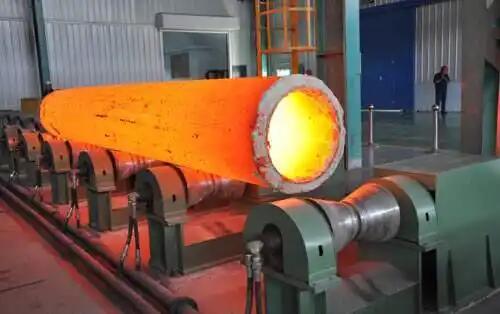The difference between annealing, normalizing, tempering and quenching of seamless steel pipes:
1. Annealing
The steel is heated to a certain temperature and kept at this temperature, and then slowly cooled to room temperature. There are several types of annealing, such as complete annealing, spheroidizing annealing, and stress relief annealing.
a. Heating the steel to a predetermined temperature, holding it for a period of time, and then slowly cooling it with the furnace is called complete annealing. The purpose is to reduce the hardness of the steel and eliminate the uneven structure and internal stress in the steel.
b. Heating the steel to 750 degrees, holding it for a period of time, slowly cooling it to below 500 ° C, and finally cooling it in the air is called spheroidizing annealing. The purpose is to reduce the hardness of the steel and improve the cutting performance, mainly used for high carbon steel.
c. Stress relief annealing is also called low temperature annealing. The steel is heated to 500~600 ℃, kept for a period of time, slowly cooled to below 300 ℃ with the furnace, and the structure does not change during the cooling annealing process at room temperature, which mainly eliminates the internal stress of the metal.

2. Normalizing
The heat treatment process of heating the steel to 30-50°C above the critical temperature, holding it for an appropriate time, and cooling it in still air is called normalizing. The main purpose of normalizing is to refine the structure, improve the properties of the steel, and obtain a structure close to the equilibrium state. Compared with the annealing process, the main difference between normalizing and annealing is that the cooling rate of normalizing is slightly faster, so the production cycle of normalizing heat treatment is short. Therefore, when annealing and normalizing can also meet the performance requirements of parts, normalizing should be used as much as possible.
3. Quenching
Heat the steel to a certain temperature above the critical point (the quenching temperature of #45 steel is 840-860°C, and the quenching temperature of carbon tool steel is 760-780°C), keep it for a certain period of time, and then heat it in water (oil) at an appropriate speed. ) The heat treatment process of cooling to obtain martensite or bainite structure is called quenching.
The main difference between quenching and annealing and normalizing in the process is that the cooling speed is fast, the purpose is to obtain the martensite structure. Martensitic structure is an unbalanced structure obtained by steel after quenching. It has high hardness, but poor plasticity and toughness. The hardness of martensite increases as the carbon content of the steel increases.
4. Tempering
After the steel is hardened, it is heated to a temperature below the critical temperature, held for a certain period of time, and then cooled to room temperature. The heat treatment process is called tempering.
Quenched steel parts generally cannot be used directly, and must be tempered before they can be used. Because of the high hardness and brittleness of quenched steel, brittle fracture often occurs when used directly. Tempering can eliminate or reduce internal stress, reduce brittleness and improve toughness; on the other hand, the mechanical properties of quenched steel can be adjusted to achieve the service performance of steel. According to the different tempering temperature, tempering can be divided into three types: low temperature tempering, medium temperature tempering and high temperature tempering.
A. Low temperature tempering 150~250℃; reduce internal stress, brittleness, maintain high hardness and wear resistance after quenching.
B. Tempering at medium temperature at 350~500℃; improve elasticity and strength.
C. High temperature tempering at 500~650℃; tempering of quenched steel parts above 500℃ is called high temperature tempering. After quenching at high temperature, quenched steel has good comprehensive mechanical properties (both certain strength and hardness, and certain plasticity and toughness). Therefore, generally medium carbon steel and medium carbon alloy steel are often treated by high temperature tempering after quenching. Shaft parts are the most used.
Quenching + high temperature tempering is called quenching and tempering.
Read more: Common Defects and Preventive Measures in Heat Treatment of Seamless Pipes


